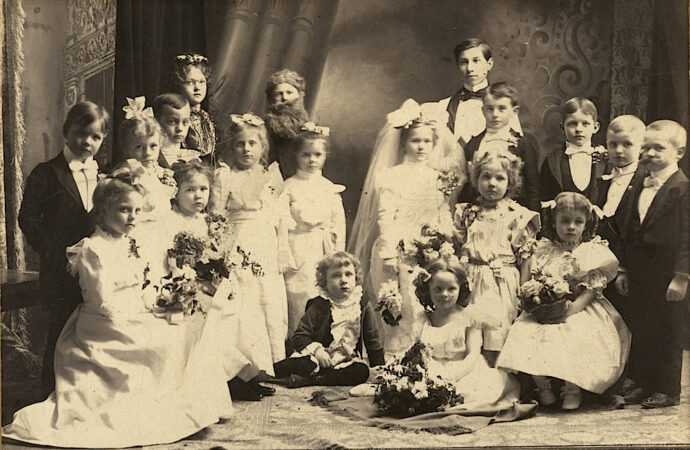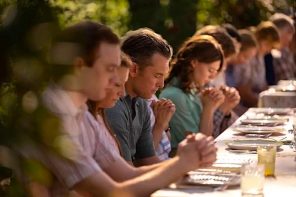The Supreme Court declined to hear five same-sex marriage cases on Monday, thus opening the door to the expansion of marriage rights into 30 states. For supporters the decision represents an unequivocal victory for equality, while for critics, this “redefinition of marriage” marks a dismaying shift away from tradition. But this latest decision is simply a variation on a theme, continuing another chapter in the nation’s centuries-old argument over the definition of marriage.
In her latest book, Leslie J. Harris, Associate Professor of Communication at the University of Wisconsin, Milwaukee, surveyed five types of 19th-century marriage controversy: domestic violence, divorce, polygamy, free love, and miscegenation. RD spoke with Harris about her project and what it reveals about our contemporary attempts to define, and redefine, marriage.
Your book is concerned with nineteenth century marriage controversies, so same-sex marriage is seldom mentioned. But it was on my mind the whole time I was reading. Did it inspire or influence your writing in any way?
Yes, the same-sex marriage controversy was an important factor in inspiring the book. I’ve been very interested in the issue for years, but I was particularly intrigued by the rash of state constitutional amendments in the early 2000s. I couldn’t help but wonder why marriage mattered so deeply to so many people.
For those advocating the amendments, marriage seemed to function as a status and idea that was much larger than any particular relationship. War metaphors were common as advocates declared that marriage was “under attack” and needed to be “defended,” and marriage was commonly represented as a sacred and unchangeable institution. While the other side of the debate emphasized the huge number of laws and policies tied to marriage, simply changing laws and policies quickly became an inadequate response. Marriage seemed to function as a status that enabled full citizenship, and advocates often made the analogy to nineteenth and early twentieth-century bans on interracial marriage.
By examining the history of these controversies we can better understand what is at stake today. In the nineteenth century the topic of marriage arose in almost every major controversy of the time including women’s rights, westward expansion, slavery, immigration, religious diversity, temperance, and state’s rights. Marriage functioned as a lens through which complex issues of belonging, identity, and status were debated.
I’ve become convinced that today’s debate about same-sex marriage is not simply about preserving a seemingly sacred and unchanging institution, or securing particular rights and privileges. Rather, it is about negotiating the boundaries of American-ness. I reference the recent Supreme Court decisions about marriage in the book’s conclusion because they illustrate this point well.
The court said that marriage enables “pride” and “dignity,” especially in reference to raising children (who were said to be humiliated by DOMA). Even as the Supreme Court seemed to open space for same-sex marriage, it (perhaps inadvertently) limited the acceptable gay family to one that models the traditional nuclear family.
Contra those who claim that marriage has always been stable and static, you show that it has been controversial for a long time. Did you observe any particular consistency or development in the arguments from controversy to controversy?
One reoccurring theme across controversies is marriage as a religious institution and the role of religion in public life. Arguments against expanding grounds for divorce, for example, consistently invoked arguments about marriage as ordained by God. If God created marriage as a permanent union between a man and woman, humans could not legitimately change the institution of marriage. Much like many current advocates for same-sex marriage, some proponents for expanding divorce laws argued that religion should be separate from politics and that marriage was essentially a civil institution.
Religious tropes were also used in attempts to change understandings of marriage. Polygamy (nineteenth century Mormons) and free love (some groups of Perfectionists) were two dramatic attempts to change marriage that were based in religious and often explicitly biblical justifications. Religion can be a malleable tool in negotiating the meaning and significance of marriage in public life.
The perceived connection between marriage and the future of the nation also has a long history. Commentators warned, for example, that increasing rates of divorce would lead to the fall of the United States, much like the fall of the Roman Republic. Similarly, polygamy was seen as causing social decline into barbarism. This technique of linking changes in marriage to a slippery slope to the nation’s destruction instilled fear of change. More importantly, however, these claims revealed underlying ideological norms about what constituted a “good” nation.
Within this reasoning, the family represents a microcosm of the nation as a whole; so it was problematic if the American family replicated seemingly barbarous families of the East, which were assumed to be polygamous. If the family looked like the racial other, the nation would begin to look like the racial other—so there were racist assumptions hidden within the image of a “good” nation.
There are, however, some temporal differences in marriage controversies. During the first half of the nineteenth century Americans were experimenting with public identity, and marriage became one site of experimentation. During this time, for example, Oneida Perfectionists practiced free love (or communal marriage) and Mormons began practicing polygamy. They were certainly controversial during their time (both groups were run out of various communities), but there seemed to be cultural space for experiments in marriage, religion, and public identity.
On the other hand, today’s marriage controversies are not only able to incorporate the powerful rhetoric of the Civil Rights Movement, but they’re further enabled by new technologies. In the nineteenth century, for example, newspapers would print vivid descriptions of individuals such as the innocent and worthy “girl” who was deceived by a violent and unscrupulous husband, which helped promote identification with audiences. Today, however, such profiles are supplemented by actual visuals. Images of hard-working and non-threatening gay couples with their children enhance that audience identification even further.
I’m interested in your observation that religion is a “malleable tool” where marriage debates are concerned. Right now the UCC church in North Carolina and the “Sister Wives” family in Utah are using a “religious liberty” argument to oppose bans on same-sex marriage and polygamy, respectively. In doing so, they turn a popular Christian Right claim back on its makers. In your view, has religion traditionally inspired marriage activism, or has it simply provided rhetorical tools to those with other agendas? Maybe a little of each?
The short answer is a little of each. I can think of some examples of marriage activism (such as campaigns against domestic violence) that were not clearly rooted in religion. Yet, religion has and continues to inspire marriage activism, occasionally for contradictory aims. I find your juxtaposition of the UCC and FLDS fascinating because it gets at a central conflict for me when I was writing about the nineteenth-century polygamy controversy. Marriage is a unique institution because it is always both public and private, and both religious and civil. What then are the freedoms and limitations to religious expression in marriage?
With nineteenth-century polygamy some of the debate was over the validity of the religion and Joseph Smith as a prophet, but a significant part of the debate was about the treatment of women in polygamy. There were sensational exposés describing the degradation and abuse of women in polygamy, but at the same time women in the Utah territory were some of the first in the nation to have full voting rights, opportunities for education, and, in many cases, unusual control over their finances and homes.
Further, some of the most vocal critics and supporters of polygamy were women, and both sides claimed to be advocating for women’s rights, protections, and Christian morality. I began my research very sympathetic with opponents to polygamy, but I came to respect the polygamist women. These women wanted the government to let them practice their religion and shape their families as they saw fit. We currently see very similar arguments with same-sex families who find themselves having to explain that they are not degraded and immoral, but they are happy and healthy.
In reference to polygamy, the Supreme Court decided that the state could limit religious liberty, and, because marriage was a “foundation of civilization,” communities should regulate the institution. Even as the court emphasized the civil dimension of marriage, the community morals used to regulate marriage are inseparable from religion. If we accept marriage as always both civil and religious, then the possibilities for marriage activism become limited. Activists can attempt to dissociate marriage and religion (as activists such as Elizabeth Cady Stanton attempted in the nineteenth century), but I suspect that this strategy will have limited success because marriage and religion are deeply connected in the American imaginary.
The alternative, then, is to control the rhetoric of religion, making marriage activism consistent with American religious norms. I’m not attempting to suggest that changing marriage simply requires an appeal to religion. It can be very difficult to argumentatively engage with moral and ethical claims because they often function as a basic premise to an argument—the “truth” on which the rest of the argument is built. An argument that appropriates the basic premise of Christian morality has more likelihood of success. While it’s difficult to know whether religion was an inspiration or tool for any given activist, in both the nineteenth century and today, much marriage activism has deep religious roots.
Does the history of marriage controversy over the past two hundred years disclose any sort of trajectory? Do you have any predictions about where our discourse around marriage and citizenship is heading?
Predictions are difficult, but I am willing to make a few claims. First, Americans tend to have a deep commitment to monogamy, and I do not think that this will change anytime soon. Some of the most radical challenges to marriage in the nineteenth century were challenges to monogamy, but those experiments were ultimately failures. The LDS church was forced to abandon polygamy, and free love communities such as Oneida eventually failed. Even as same-sex marriage becomes increasingly acceptable in the United States, it is framed to model the traditional nuclear family.
Second, I do not think that marriage will go away. Marriage is an important way of structuring relationships, and in the US ways of thinking about marriage have a tendency to replicate government models (I call this the family-as-government metaphor). Because ways of thinking about family and government tend to be deeply intertwined, I think that marriage is here to stay (at least for the foreseeable future).
Although it may be tempting to look for a clear linear trajectory with marriage controversies, the reality is more complex. Marriage is fascinating because the institution is about much more than love and personal commitment; it’s a lens through which Americans attempt to understand who we are and what we believe. Ultimately, marriage controversy is rooted in the anxieties and conflicts of a time, so the ebbs and flows of American identity become reflected back in these controversies.





